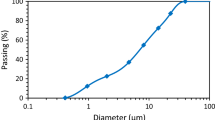Abstract
A laboratory testing programme of granular materials stabilized with cement has been implemented in order to determine the influence of changes in mix composition on their mechanical characteristics. The elements of the composition of stabilized mixes such as gradation, cement content, cement type, density and curing time were varied. The results obtained were analysed statistically and three types of correlation were determined. It is concluded that the relationship between the dynamic modulus of elasticity and the pulse velocity is almost unaffected by individual composition parameters, while the relationship between compressive and tensile strength, and especially that of compressive strength and dynamic modulus of elasticity, is dependent on these parameters.
Similar content being viewed by others
References
Lister, N. W., ‘Design and Performance of Cement—Bound Bases’,Inst. Highway Engineers,14 (1972), pp. 21–33.
Radojković, Z., Babić, B., Sršen, M., Stojadinović, S., Vojnić, Ž., Žmavc, J., XVIII World Road Congress Bruxelles 1987, Question II ‘Construction and Maintenance of Flexible Pavements’ (National Report of Yugoslavia) pp. 373–393.
Babić, B., ‘The Effect of Changes in Composition on Engineering Properties of Cement Stabilized Gravel Mixes’, PhD thesis, University of Zagreb (1981), pp. 277 (in serbo-croatian).
Babić, B., ‘The Effect of Changes in Composition on Properties of Cement Stabilized Bases’, Proceedings of XI Congress of Yugoslav Road Societies Association, Opatija, 1982, Vol. 1, pp. 503–510. (in serbo-croatian).
Hranilović, M., Babić, B., Ukrainčik, V., Trkmić, H., ‘Development of Hydraulic Binder for Use in Cement —Bound Bases in Pavement Structures’, Proceedings of XVI Congress of Association of Yugoslav Testing Laboratories, Vrnjačka Banja, 1978, Vol. I, 1–3, pp. 1–14 (in serbo-croatian).
Yugoslav Standard Institution, JUS U.E9.024, Construction of Pavement Base Courses Stabilized by Means of Portland Cement and Similar Chemicals. Technical Requirements (1980).
Hudson, N. R., Kennedy, T. W., ‘An Indirect Tensile Test for Stabilized Materials’, Research Report 98-1. Project 3-8-66-9 (Center for Highway Research, The University of Texas at Austin, 1968).
Malhotra, V. M., ‘Testing Hardened Concrete: Nondestructive Methods’, American Concrete Institute Monograph9 (1976) p. 185.
Brunarski, L., ‘Recommendations for the Use of Resonance Methods for Testing Concrete’, RILEM Recommendation2, Paris (1974), pp. 269–273.
PUNDIT Manual for Use with the Portable Ultrasonic Non-Destructive Digital Indicating Tester (C.N.S. Instruments Ltd, London), p. 43.
Felt, E. J., Abrams, M. S., ‘Strength and Elastic Properties of Compacted Soil-Cement Mixtures’, ASTM Special Technical Publication, No. 206, 1957, pp. 152–178.
Kolias, S., Williams, R. I. T., ‘Relationships Between the Static and the Dynamic Moduli of Elasticity in Cement Stabilised Materials’,Mater. Struct. 13 (1980), 99–107.
Williams, R. I. T., ‘The Effect of Cement Content on the Strength and Elastic Properties of Dry Lean Concrete’, Cement and Concrete Association, Technical. Report TRA/323 (London, 1962).
Sherwood, P. T., ‘The Properties of Cement Stabilized Materials’, Road Research Laboratory Report LR 205, 1968.
Springenschmidt, R., Wagner Grey V., Sonnewald, P., ‘Einfluss der Mineralstoffe auf die Biegezugfestigkeit hydraulisch gebundener Tragschichen’,Strasse und Autobahn 29 (1978), 536–539.
Franklin, R. E., King, T. M. J., ‘Relations Between Compressive and Indirect Tensile Strengths of Concrete’, Transport and Road Research Laboratory Reports LR 412 (Crowthorne, 1971).
Dac Chi N.et al., ‘Nouvelles méthodes d'étude en laboratoire des propriétés mécaniques des matériaux d'assises traitées aux liants hydrauliques’, LCPC (Nantes, 1974).
Williams, R. I. T., Patankar, V. D., ‘The Effect of Cement Type, Aggregate Type and Mix Water Content on the Properties of Lean Concrete Mixes’,Roads and Road Construction 46 (1968) pp. 34–42.
Jones, R., ‘Measurement of Elastic and Strength Properties of Cemented Materials’ inRoad Bases, Highway Research Record 128 (1966), pp. 101–111.
Author information
Authors and Affiliations
Rights and permissions
About this article
Cite this article
Babić, B. Relationships between mechanical properties of cement stabilized materials. Materials and Structures 20, 455–460 (1987). https://doi.org/10.1007/BF02472497
Published:
Issue Date:
DOI: https://doi.org/10.1007/BF02472497



